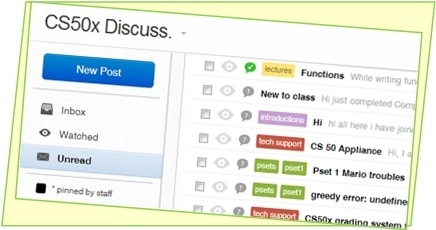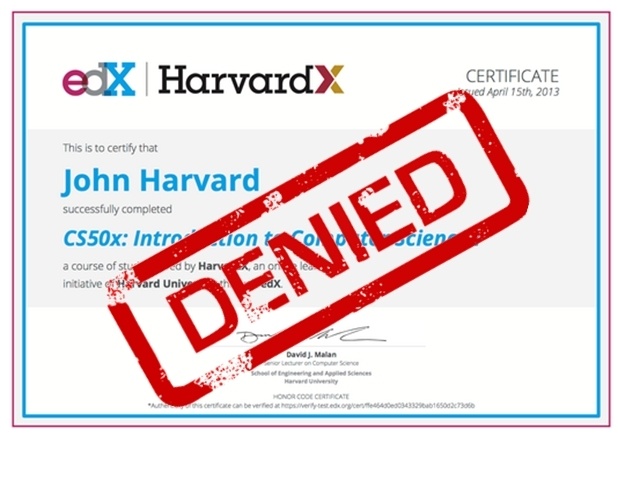Harvard MOOC story - Part 4
To be fair, I’m in what the course calls “the less comfortable section,” when it comes to programming knowledge, so I just don’t have much to provide in the way of advice when someone is asking for help finding a bug in their code. I don’t know whether too feel bad about this, but I take answers from the board; I don’t give them. This self-actualizing assessment of my discussion board parasitism led to a few questions that are important for designers of online courses to consider.
What proportion of students needs to know what they’re doing in order to ensure that the group’s progress
Too few helpful students, and the questions of the confused majority will not be answered quickly enough, and the faculty are too outnumbered by the 100,000 students to keep up. With CS50, it is acknowledged that there are students in the “hacker section” that know what they are doing. I don’t know if all courses could assume that such a knowledgeable group would exist to act as peer teachers. Course designers would need to assess this, and possibly include more resources to help struggling students, if the peer teaching strategy isn’t keeping up with the demand.
How do you ensure that the knowledgeable peers will make the effort to help others?
In most MOOCs there is no compulsory discussion board requirement, and they rely on the good nature of the students to inspire the interaction. How is that enough to keep the class going? This problem is solved by what is advertised as one of the greatest advantages (and challenges) of a MOOC: its “massive” enrollment. In a class of 100, let’s say that a 5% rate of go-getters is leading the charge. With a MOOC, the same rate equals 4,995 more potential teachers. If even a fraction of them are plugged into the discussion boards on a regular basis, the course will have a great infusion of student-led assistance. So maybe that first question of mine will never be a problem for a MOOC. The strong sense of unity and mutual endeavor that CS50 promoted from day 1 (again, they have proudly-worn t-shirts) is probably the best way to tap into this potential.
How should Q&A discussion boards be set up in a course? Where should they live?
I’m not talking about the usual “Respond to the chapter you just read,” discussion boards. It’s the, “Hey, here’s something that I ran into. Can anyone help me?” questions that don’t seem to have a good home in most courses. If these exist in a course, they tend to be labeled something like, “General Q&A,” and students just don’t use them. Questions sit, unanswered. Busy students are focused on the current week’s board (for a grade), not the one that has been mostly empty since the first week of class. With this in mind, instructors should provide a fresh thread with each week or unit, which invites students to ask their individual questions. It stays current for both askers and answerers, and all of the students who are neither.
Should the Q&A discussions be graded?
While it’s probably not appropriate to require this type of question that is often tangential to the lesson or about one student’s specific situation, these discussions often involve much deeper thinking than an assignment requires, and they can often break new ground for the students, as well as the instructor. Because of this, it is a good idea to reward this interaction. It adds a great deal to what Bill Pelz, professor at Herkimer County Community College, Sloan Consortium award winner, and someone with whom any online education specialist should become familiar, calls “Social Presence” and “Teaching Presence".
He can explain it better than I can:
Bill Pelz on Social Presence
Developing the sense of collaboration in learning is something that this “extra” discussion thread can provide, and students should be rewarded for contributing to it.A couple of other take-aways along different lines:
- Show students in your classroom videos – I didn’t realize that it bothered me until it was changed, but the previous weeks’ videos of small group meetings only showed the instructor. Students asked questions off-camera, and he talked with them and answered the questions, but the camera stayed in place the whole time. This week the camera moved around the room to actually show the other students in these interactions, and it made a big difference in how I perceived the group session. It felt more like a real class, and I felt much more like a “real” student.
- “Review, Review, Review” – as stated by my Teaching Methods instructor in college. I think that in online classes there is a tendency to complete modules and move on without looking back. The group session this week looked at student code from previous problem sets, and students compared different strategies, and pinpointed better and worse practices. Don’t forget to review content multiple times in later modules to maximize student reflection and retention.
- Show students the deep end of the pool – We often teach isolated skills with the mantra, “You’ll need to know how to use this later when you do __(blank)_.” Students only believe that for so long. When will “later” happen? This week’s assignment showed us what “later” looks like by having the problem set come from a giant, scary program for a simple word scramble game. We had three tasks to complete in order to make the game work correctly. We didn’t need to completely understand the entire code of the program, but it was explained to us at a level appropriate for our current level of understanding and our current need. It gave a much better idea of the scope of what we are working toward, in a non-threatening way, since we only needed to worry about a small sample of the big problem.
So that’s the latest on what Harvard’s CS50 MOOC is teaching me about online course design. Thanks for reading. Stay tuned for more.
You may also find the following articles useful:
- What I'm learning from Harvard: A MOOC story - Part 1
- What I'm learning from Harvard: A MOOC story - Part 2
- What I'm learning from Harvard: A MOOC story - Part 3
- What I'm learning from Harvard: A MOOC story - Part 4
- What I'm learning from Harvard: A MOOC story - Part 5
- What I Learned from Harvard: MOOC Story Wrap-up
- Converting Large Group Classes to Massive Online Courses
- The Rise and History of MOOCs - Infographic and Prezi Presentation






